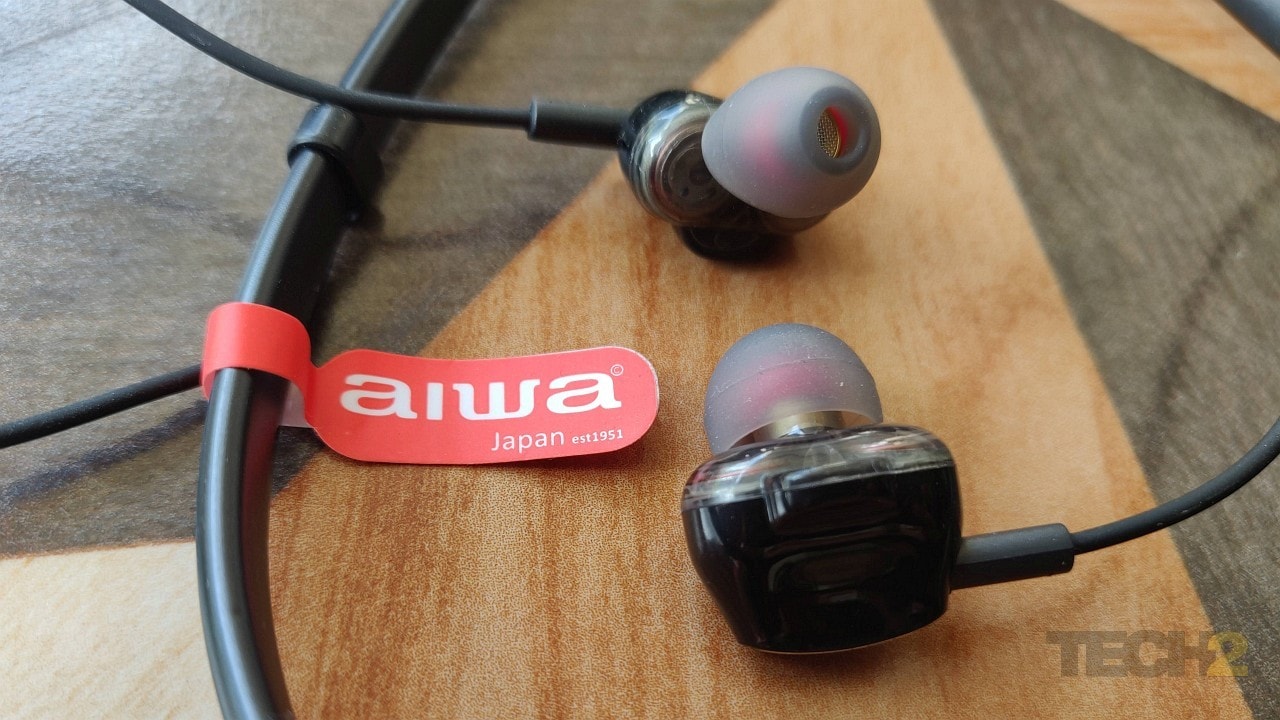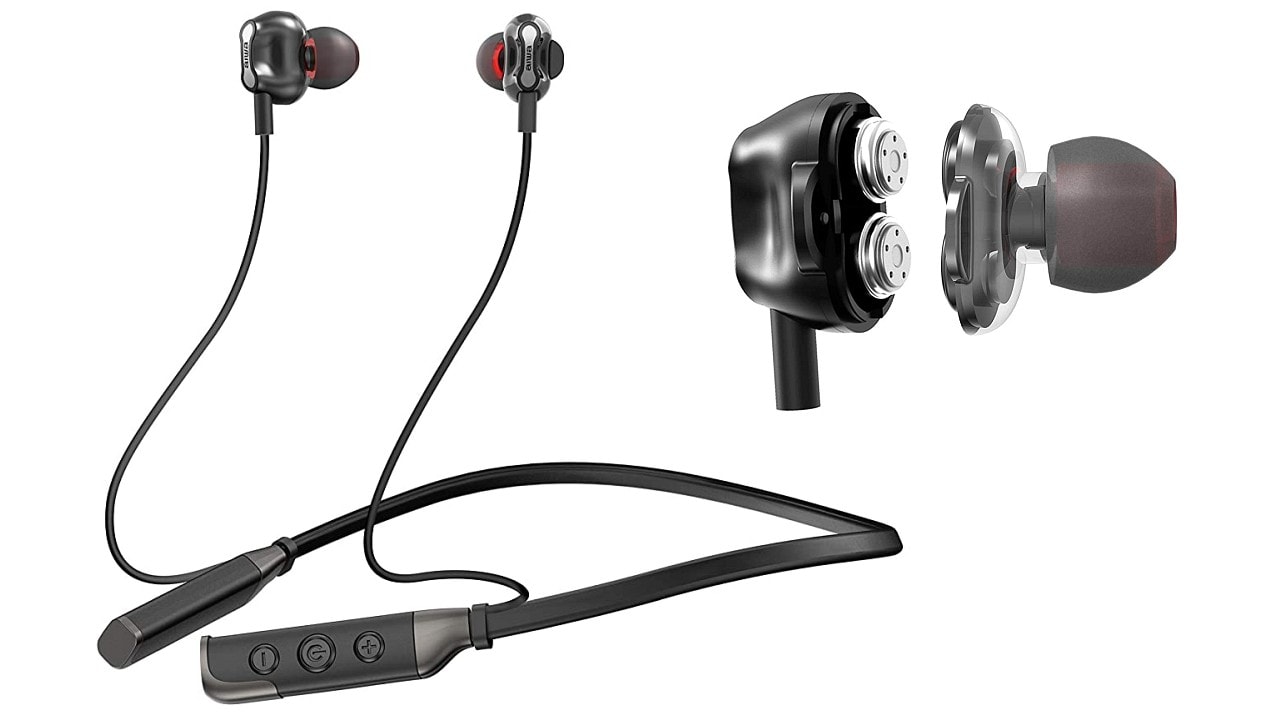Aiwa AT-X80FANC TWS buds, Aiwa ESBT-460 quad-driver wireless neckband review snapshots- Technology News, Firstpost
Ameya DalviJul 01, 2021 10:59:47 IST
The brand Aiwa makes me nostalgic. Some of you may not be old enough to feel the same way, but back in the day, Aiwa used to be a dominant player in the audio segment. Incidentally, my first portable cassette player, colloquially known as the Walkman back then (sorry, Sony), was made by Aiwa. They had some high-quality earphones, too. Then the brand went missing from India for a long time. Now, it seems to be back, and it’s looking to regain lost ground with a handful of interesting products.
We will be taking a close look at a couple of its products – the first being TWS buds with active noise cancellation (ANC), and the other, a dual-driver wireless neckband. Let’s see if the company can make a dent in the highly crowded and equally competitive wireless earphones market in India.
Aiwa AT-X80FANC TWS buds review
Aiwa AT-X80FANC TWS buds. Image: Tech2/Ameya Dalvi
Aiwa launched the AT-X80FANC true wireless earbuds in India at Rs 7,999, and our bar of expectations was set accordingly. But for a pair going almost Rs 8,000, the feature list seems quite scanty. There is no support for superior codecs such as aptX or LDAC, no wireless charging or wear detection, and there seems to be no ingress protection either (no IP rating to suggest otherwise). The design isn’t something I would call premium, but the all-black glossy earbuds seem well built, and more importantly, are extremely comfortable to wear, courtesy of the lightweight and silicone ear tips.
The back of the earphones has a touch-enabled zone, but the controls aren’t programmable; so, you will have to make do with the default settings. There is no companion app, so you cannot alter the sound profile either. Coming back to the touch gestures, some thought has been put into them to provide more controls on the buds themselves. A single tap is needed to play/pause, a double-tap to increase or decrease the volume, a two-second-long touch to skip to the next or previous track and a four-second-long touch on the right bud to toggle between ANC on/off and transparency mode. A double-tap can also be used to answer or end calls. The touch controls are quite responsive.
Three pairs of ear tips are bundled in the package, including the preinstalled medium-sized pair, which worked best for me. With the right-sized tips, passive noise isolation is decent, but the ANC isn’t the greatest I have come across. In fact, I would say it’s barely functional. It does reduce ambient sounds of a certain frequency, but it’s not enough. Incidentally, the Oppo W51 (Review) or the Realme Buds Air 2 (Review) (priced significantly lower than this Aiwa pair) do a far better job in this department. Transparency mode is quite good here and feels natural.
With the right sized tips, passive noise isolation is decent, but the ANC isn’t the greatest I have come across.
The Aiwa AT-X80FANC supports SBC and AAC codecs, and the output is fairly loud, but the sound quality is nothing like one would expect from a pair of TWS earphones priced at Rs 8,000. With the abundance of bass on offer, it seems to be targeted at bassheads. The extra bass is somewhat balanced by reasonably well-tempered highs, but the mids are quite weak. They often get overshadowed by the lows, with certain instrument sounds getting drowned out and vocals being impacted in bass-heavy tracks. You get a V-shaped sound profile here that you generally find in TWS buds available for less than half the Aiwa buds’ selling price.
As I mentioned earlier, its other key feature (ANC) is also far from impressive, so the premium isn’t justified. Call quality with these buds is quite good, though, with both parties clearly audible to each other. A bit of ambient noise can be heard, but it doesn’t hamper the conversation. The wireless range for these Bluetooth 5.0-compliant buds is perfectly fine, with a solid connection of up to 10 metres with a clear line of sight, and a little more than half that with a concrete wall in between. They are also easy to pair with the source device.

Although this product gets close to the battery backup figure advertised by the company, these aren’t great numbers in this day and age. Image: Tech2/Ameya Dalvi
Battery backup is not a strong point of this product. The buds last just a shade over three and a half hours with intermittent use of ANC, and the case manages to charge them a little more than two times, taking the overall battery backup to close to 12 hours (buds + case combined). Although this product gets close to the battery backup figure advertised by the company, these aren’t great numbers in this day and age, where the figure needs to be upwards of 20 hours for buds and case combined. The case has a USB-C port, and takes about an hour to charge fully, which is good.
As I mentioned at the start, the Aiwa AT-X80FANC TWS buds are priced at Rs 7,999 with a one-year warranty, and can often be found going for around Rs 6,000 on Amazon India. Even then, the buds don’t have much going for them to earn our recommendation. The Realme Buds Air 2 that sell for as low as Rs 3,299 manage to outperform these Aiwa buds in almost every department, including sound quality and ANC. I agree that the Buds Air 2 is an exception rather than the norm at that price point, but then, you also have the Oppo Enco W51 with ANC, priced at Rs 4,499, that performs even better and looks a lot more premium. These Aiwa buds don’t sound bad, but there’s nothing here that justifies the premium they demand.
Pros:
- Lightweight and comfortable to wear
- Good for bassheads
- Good call quality
- Responsive touch controls
- USB-C charging
Cons:
- Expensive; sound quality not worth the asking price
- Below-par ANC
- Sound is too bass-heavy and lacks detail
- No support for aptX or LDAC codecs
- No ingress rating
- Average battery life
Rating: 3/5 (at Rs 6,000)
Price: Rs 6000 to Rs 7,999
Aiwa ESBT-460 Quad-driver Wireless Neckband Review

Aiwa ESBT-460 Quad-driver Wireless Neckband. Image: Tech2/Ameya Dalvi
The Aiwa ESBT-460 looked quite interesting on paper, given the presence of dual drivers in each of the earphones. Yes Aiwa, this setup is called dual-driver, not quad-driver. However, it ends up being nothing more than a gimmick, as the wireless neckband derives no real benefit from the presence of the extra drivers. The pricing isn’t as exorbitant as the AT-X80FANC, but the sound quality takes a further hit, as does codec support. While the TWS buds have support for AAC, one must contend with just SBC on this neckband. The USB-C port has also been replaced with a micro-USB port here. There is no ANC either.

The inline control pod has three buttons that grant access to all key functions of this neckband. Image: Tech2/Ameya Dalvi
The Aiwa ESBT-460 does offer a couple of extra features, though, that may be useful to some. Firstly, it vibrates when you get an incoming call, and while we are on the subject, I would like to add the call quality is rather good, too, with people on either side of the line perfectly audible to each other. Again, a bit of ambient noise does sneak through, but it’s manageable. Secondly, this neckband has a microSD card slot, and if you choose to load some (legit) MP3 files on a card, this band can serve as a standalone audio player without needing to be paired with a phone.
Battery life here is decent, with the neckband clocking over 13 hours of playback at 70-75 percent volume level. While you have wireless neckbands breaching the 24-hour mark for battery backup, I consider a minimum of 12 hours as the baseline in this department. It takes about two hours to charge them fully with a standard micro-USB charger. This Bluetooth 5.0-compliant neckband is satisfactory in terms of the wireless range and manages to retain a strong connection for the advertised 10-meter distance with a clear line of sight.

This neckband has two drivers in each earphone.
Coming to the business end of the review, sound quality is where this Aiwa neckband falters. The sound profile is somewhat like the AT-X80FANC’s, but with even less detail. The bass isn’t as excessive but sounds muddy. There is too much auditory masking in the mids, and they sound weak, with poor instrument separation. The highs are decent, but they roll off a bit too soon and lack the right amount of sparkle. This is not the kind of output I was expecting from a dual-driver setup, where typically one driver takes care of one frequency band while the other handles the rest. That doesn’t seem to be happening with the dual 8 mm drivers, and this Aiwa neckband sounds like any entry-level neckband selling for less than half its price.
On the bright side, the neckband sits comfortably around your neck, and the buds are equally comfortable in the ear. One thing to note is that it is of paramount importance to choose the right sized ear tips from the three bundled pairs, and not just that, but also adjust the earphones in the ear so that you get the sound right. Else, they sound terrible. One tell-tale sign that you’re wearing them wrong is the complete lack of bass. Just try turning them a bit or changing the tips till you start hearing ample bass.
The inline control pod has three buttons that grant access to all key functions of this neckband. They let you switch the earphones on and off, play/pause the audio, adjust the volume, skip tracks and answer/end/reject calls. The buttons have a nice, tactile feel to them. The back of the earbud does not have a magnetic tip, so you can’t get them to stick together, let alone put them in standby mode.
The Aiwa ESBT-460 wireless neckband is priced at Rs 2,999, and once again, you have products priced under Rs 2,000 that comfortably outperform it. Two that come to mind straight away are the Oppo Enco M31 and OnePlus Bullets Wireless Z (Review). Neither flaunt dual-drivers, but sound significantly better than this Aiwa neckband. The OnePlus band has a much better battery life, too. You even get better-sounding TWS buds for under Rs 3,000 like the OnePlus Buds Z (Review), leaving us with no option but to give the Aiwa ESBT-460 a miss.
The Aiwa brand is reputed and may make some feel nostalgic, but it isn’t aspirational enough yet to demand a hefty premium for the brand name alone. I am sure the company can do better than the products we saw here today and will need to up its game if it is serious about succeeding in India. But before it launches its next set of products, it would serve Aiwa well to thoroughly research the prevailing competition in India, and focus on not just the output quality, but also the features buyers get at every price point.
Pros:
- Built-in audio player
- Good call quality
- Vibrates for incoming calls
- Decent battery life; over 13 hours of playback
Cons:
- Quad drivers just a gimmick
- Below-par sound quality
- No ingress rating
- No support for any HD codecs; not even AAC
- Micro-USB charging
- Far better alternatives available for a lower price
Rating: 2.75/5
Price: Rs 2,999
For all the latest Technology News Click Here
For the latest news and updates, follow us on Google News.
